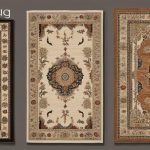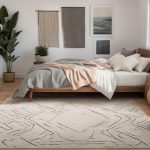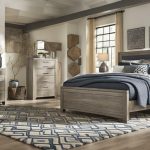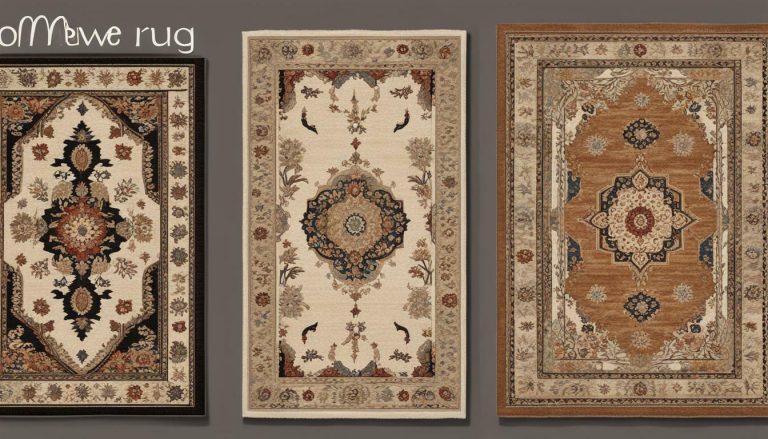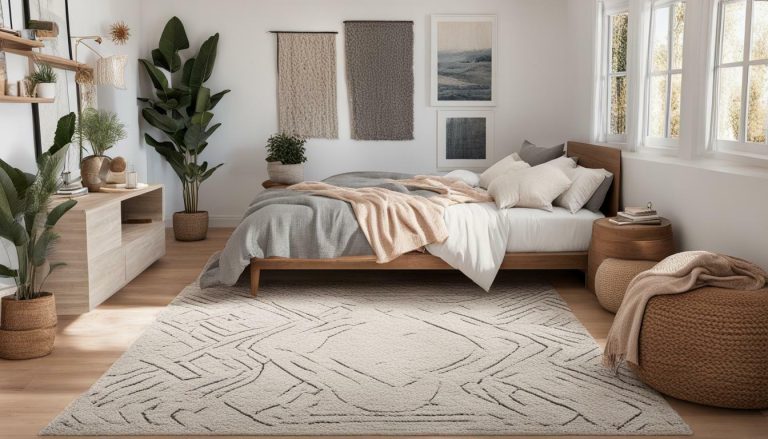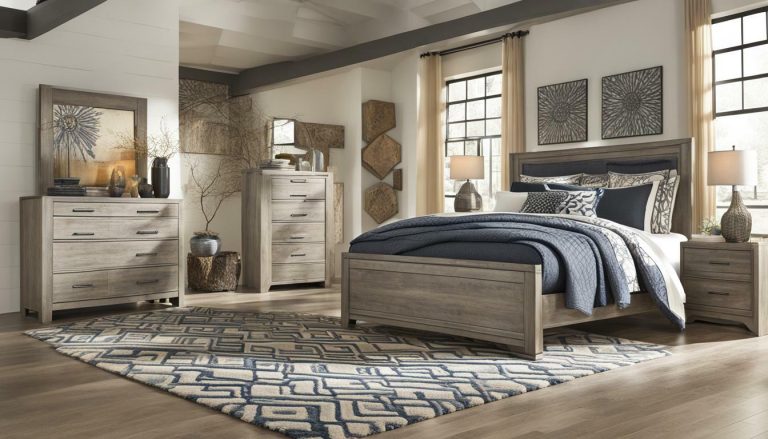If you’re in the market for a new rug, you may be wondering which type is right for your home: olefin or wool? Both have their own unique characteristics and benefits, so it’s important to understand the differences before making a purchase.
In this comparison guide, we’ll take a closer look at olefin rugs and wool rugs, exploring their properties, durability, stain resistance, comfort, appearance, eco-friendliness, cost, maintenance, and potential allergenic properties. By the end of this article, you’ll have a better understanding of which type of rug is the right fit for you.
Key Takeaways
- There are distinct differences between olefin rugs and wool rugs, including their properties, durability, stain resistance, comfort, appearance, eco-friendliness, cost, maintenance, and potential allergenic properties.
- When choosing between olefin rugs and wool rugs, consider factors such as the level of foot traffic, desired level of comfort, preferred style, and budget.
- Proper maintenance and care are crucial for extending the lifespan of both olefin and wool rugs.
What is Olefin?
Olefin, also known as polypropylene, is a synthetic fiber commonly used in rug manufacturing. It is a very affordable material that is known for its durability and resistance to stains, fading, and moisture. Olefin rugs are often used in high-traffic areas of the home, such as hallways and entryways, as well as outdoor spaces like patios and decks.
Properties of Olefin Rugs
Olefin rugs are made by creating fibers from melted plastic pellets, which are then woven into a rug backing material. Some of the key properties of olefin rugs include:
| Property | Description |
|---|---|
| Durability | Olefin is a very durable material that can withstand heavy foot traffic and resist wear and tear over time. |
| Stain Resistance | Olefin fibers are naturally moisture-resistant, which makes them resistant to stains and spills. However, they can be difficult to clean once stained. |
| Appearance | Olefin rugs have a slightly shiny appearance and can have a flat, uniform texture. They are available in a range of colors and patterns. |
| Comfort | Olefin rugs are not as soft or comfortable underfoot as other materials like wool, but they are still relatively comfortable to walk on. |
| Eco-Friendliness | Olefin is a synthetic material that is not biodegradable, so it is not the most eco-friendly choice for rug materials. |
| Cost | Olefin rugs are generally very affordable, making them a popular choice for budget-conscious shoppers. |
If you’re looking for a rug that is durable, affordable, and resistant to stains and moisture, an olefin rug may be a good choice for you. However, keep in mind that they may not be as comfortable or eco-friendly as other options, so it’s important to weigh the pros and cons before making a final decision.
What are Wool Rugs?
If you’re considering wool rugs for your home, it’s important to understand what they are and their unique properties. Wool is a natural fiber derived from the fleece of sheep. It is known for its durability, softness, and natural resistance to fire, water, and stains.
The manufacturing process for wool rugs involves shearing the sheep, cleaning and carding the fleece, spinning the wool into yarn, and weaving or tufting the yarn into a rug. Wool rugs come in a variety of styles and designs, and can be dyed in a wide range of colors.
One of the key benefits of wool rugs is their durability. Wool fibers are naturally strong and resilient, which means they can withstand heavy foot traffic without showing signs of wear and tear. Additionally, wool rugs are naturally stain-resistant, making them easy to care for and maintain.
However, there are some downsides to wool rugs. They can be more expensive than synthetic rugs, and their natural fibers can attract dust and dirt, which means they may require more frequent cleaning than other types of rugs. Additionally, some individuals may be allergic to wool, which can make it an unsuitable choice for them.
If you’re looking for a natural, durable, and stylish rug for your home, wool rugs may be a good option to consider.
Durability and Longevity
When it comes to determining the durability and longevity of a rug, both olefin and wool have their respective strengths and weaknesses.
| Rug Material | Durability | Longevity |
|---|---|---|
| Olefin | Olefin rugs are highly resilient and resistant to wear and tear. They can withstand heavy foot traffic without showing signs of damage. | While olefin rugs are durable, they tend to have a shorter lifespan than wool rugs due to their synthetic nature and susceptibility to fading. |
| Wool | Wool rugs are renowned for their durability and ability to resist wear and tear. They are perfect for high-traffic areas like living rooms, hallways, and entryways. | Wool rugs can last for decades, making them a long-term investment for your home. However, they may require periodic maintenance and cleaning to ensure their longevity. |
Factors such as foot traffic, placement, and maintenance can also affect the lifespan of both types of rugs. Regular vacuuming and professional cleaning can help extend the life of your rug.
Stain Resistance
When it comes to spills and stains, both olefin rugs and wool rugs have their pros and cons.
Olefin rugs are known for their excellent stain resistance, thanks to the fact that the fibers do not absorb liquid as readily as wool. This means that spills and stains tend to sit on the surface of the rug, making them easier to clean. In addition, olefin is resistant to fading, making it an ideal choice for rooms that receive a lot of sunlight.
Wool rugs, on the other hand, are naturally more stain-resistant than many other types of rugs. The fibers contain lanolin, a natural oil that repels moisture and dirt. However, wool does absorb moisture more readily than olefin, which means that it may be more prone to staining if spills are not cleaned up quickly. Wool is also more susceptible to fading, particularly in direct sunlight.
If you have children or pets, or if you entertain frequently, olefin rugs may be a better choice due to their superior stain resistance. However, if you are looking for a rug that is naturally more resistant to stains and spills, wool may be the way to go.
Comfort and Texture
When it comes to comfort and texture, wool rugs have a clear advantage over olefin rugs. Wool fibers are naturally soft, plush, and warm, making them ideal for creating cozy and comfortable spaces in your home. Walking barefoot on a wool rug can feel luxurious and soothing.
Olefin rugs, on the other hand, can feel more synthetic and stiff underfoot. While they can still be comfortable to walk on, they lack the softness and warmth of wool rugs. Additionally, the texture of olefin rugs can be more uniform and less varied than wool rugs, which can lead to a less interesting visual appearance.
One advantage of olefin rugs in terms of texture is that they can be designed to mimic the look and feel of other materials, such as wool or silk, at a lower cost. However, if you’re looking for true comfort and texture, wool rugs are the way to go.
Appearance and Style
When it comes to appearance and style, both olefin rugs and wool rugs offer a wide range of options. Olefin rugs are typically available in bold colors and modern designs, making them a popular choice for contemporary homes. They can also mimic the look and texture of natural fibers, such as wool or jute, at a lower cost.
Wool rugs, on the other hand, are known for their classic and timeless look. They often come in more muted colors and traditional patterns, such as floral or oriental designs. Wool rugs can add warmth and a sense of coziness to a room, making them a great choice for more traditional or rustic interiors.
Both types of rugs can complement different interior design styles, depending on individual preferences and the specific décor of the room. Whether you prefer a modern, minimalistic look or a more traditional, eclectic style, there is an olefin or wool rug out there to suit your needs.
Eco-Friendliness
When it comes to eco-friendliness, wool rugs have the upper hand over olefin rugs. Wool is a renewable resource as sheep grow new fleece every year. It also has a lower carbon footprint than olefin production. On the other hand, olefin is a synthetic fiber made from plastic, which is derived from non-renewable resources like petroleum.
In terms of manufacturing, wool rugs are typically made using natural dyes and organic materials, which reduce their impact on the environment. Olefin rugs are often manufactured using harsh chemicals, which can pollute the air and water.
If you are looking for an eco-friendly option, wool rugs are the better choice. However, it is important to note that the sustainability of wool rugs also depends on the farming practices used to raise the sheep. Look for rugs made from wool sourced from farms that prioritize ethical and sustainable practices.
Cost
When it comes to cost, olefin rugs are typically more affordable than wool rugs. This is because olefin is a synthetic material that is easier and less expensive to produce, compared to the natural fibers used in wool rugs. However, the cost of olefin rugs may vary depending on factors such as quality, size, and design. On the other hand, wool rugs are generally more expensive due to their high-quality material and production process. Wool rugs may also have a higher resale value than olefin rugs, making them a better investment in the long run.
Maintenance and Care
To keep your olefin rug in good condition, vacuum it regularly to remove any loose dirt or debris. If you spill something on the rug, clean it up immediately with a damp cloth and mild soap, working from the outside in to avoid spreading the stain. Avoid using harsh cleaners or bleach on your olefin rug, as this may damage or discolor the fibers. If your rug becomes heavily soiled, consider hiring a professional cleaning service.
Wool rugs require a bit more attention and care. Vacuum your wool rug at least once a week to prevent dirt and dust from settling into the fibers. If you spill something on the rug, absorb as much of the liquid as possible with a clean cloth or paper towel, and then blot the area with a mixture of water and mild soap. Avoid rubbing the stain, as this can damage the fibers. Wool rugs should be professionally cleaned every 12-18 months to keep them looking their best.
Allergies and Sensitivities
When it comes to allergies and sensitivities, both olefin rugs and wool rugs can potentially cause issues for some individuals.
For olefin rugs, the synthetic nature of the material can lead to off-gassing of volatile organic compounds (VOCs), which can cause respiratory irritation in sensitive individuals. Additionally, olefin fibers can trap dust and other allergens, making it difficult to fully clean the rug.
Wool rugs, on the other hand, can cause issues for those allergic to lanolin, a natural oil present in wool fibers. In addition, wool rugs can trap allergens such as dust, pet dander, and mold, requiring regular cleaning and maintenance.
If you have allergies or sensitivities, it’s important to carefully consider the potential risks and benefits of each type of rug before making a purchase. You may want to opt for a rug made of natural fibers that are less likely to cause respiratory irritation or allergic reactions, or choose a low-pile rug that is easier to clean and maintain.
Conclusion
After comparing olefin rugs and wool rugs based on various factors, it is clear that both have their advantages and disadvantages. The choice between the two types of rugs ultimately depends on your personal preferences and needs.
If you prioritize durability and stain resistance, olefin rugs may be a better option as they are less likely to wear and are easier to clean. However, if you value comfort and texture, wool rugs are the way to go as they offer a softer and cozier feel underfoot.
When it comes to appearance and style, both olefin and wool rugs come in a variety of colors, patterns, and designs to suit different interior design preferences.
If you are concerned about the environment, wool rugs may be a better choice as they are made from a natural and renewable material. However, the manufacturing process of both types of rugs can have an impact on the environment.
Cost is also a key factor to consider, with olefin rugs generally being more affordable than wool rugs due to the difference in material quality and production methods.
Finally, when it comes to maintenance and care, both olefin and wool rugs require regular vacuuming and spot cleaning. However, wool rugs may need more specialized and frequent cleaning to maintain their quality.
Final Recommendation
Ultimately, the decision between olefin rugs and wool rugs depends on your priorities and preferences. Consider factors such as durability, comfort, appearance, eco-friendliness, cost, and maintenance requirements before making a decision.
If you are looking for a budget-friendly option that is easy to maintain and offers good stain resistance, olefin rugs may be the better choice. However, if you value softness, warmth, and eco-friendliness, wool rugs are worth the investment.
Remember to consider your specific needs and priorities before making a final decision.
FAQ
Q: What is the difference between olefin rugs and wool rugs?
A: Olefin rugs and wool rugs differ in terms of materials used, durability, stain resistance, comfort, appearance, eco-friendliness, cost, maintenance, and potential allergies. This article provides a detailed comparison of the two types of rugs.
Q: What is olefin?
A: Olefin, also known as polypropylene, is a synthetic fiber commonly used in rug manufacturing. Olefin rugs are known for their durability and resistance to stains, but they may lack the softness and comfort of natural fibers like wool.
Q: What are wool rugs?
A: Wool rugs are made from the natural fibers of sheep’s wool. They are known for their softness, warmth, and luxurious feel. Wool rugs also have excellent durability and stain resistance, although they may require more maintenance compared to synthetic rugs.
Q: How durable are olefin rugs and wool rugs?
A: Olefin rugs and wool rugs are both durable options. However, wool rugs generally have a longer lifespan and can withstand high foot traffic areas better than olefin rugs.
Q: Are olefin rugs or wool rugs more stain-resistant?
A: Olefin rugs are highly resistant to stains and are easy to clean. Wool rugs also have good stain resistance properties, but they may require special care and treatment for certain types of stains.
Q: Which is more comfortable, olefin rugs or wool rugs?
A: Wool rugs are considered to be more comfortable and softer underfoot compared to olefin rugs. Wool’s natural fibers provide warmth and a cozy feel.
Q: How do olefin rugs and wool rugs differ in appearance and style?
A: Olefin rugs and wool rugs come in a variety of colors, patterns, and designs. However, wool rugs have a natural luster and richness in appearance, while olefin rugs may have a more synthetic look.
Q: Are olefin rugs or wool rugs more eco-friendly?
A: Wool rugs are considered more eco-friendly as they are made from natural and renewable materials. Olefin rugs, being synthetic, have a lower environmental impact compared to some other types of synthetic rugs, but they are not as sustainable as wool.
Q: How do the costs of olefin rugs and wool rugs compare?
A: Olefin rugs are generally more affordable than wool rugs. The cost of wool rugs can be higher due to the higher quality of the material and the manufacturing process involved.
Q: What is the maintenance and care required for olefin rugs and wool rugs?
A: Olefin rugs are low maintenance and can be easily cleaned with regular vacuuming and spot cleaning. Wool rugs require more care, including regular vacuuming, professional cleaning, and specific care instructions to maintain their quality and appearance.
Q: Can olefin rugs or wool rugs trigger allergies?
A: Some individuals may have allergies or sensitivities to the synthetic fibers in olefin rugs. Wool rugs, on the other hand, are known to be hypoallergenic and less likely to cause allergic reactions.




